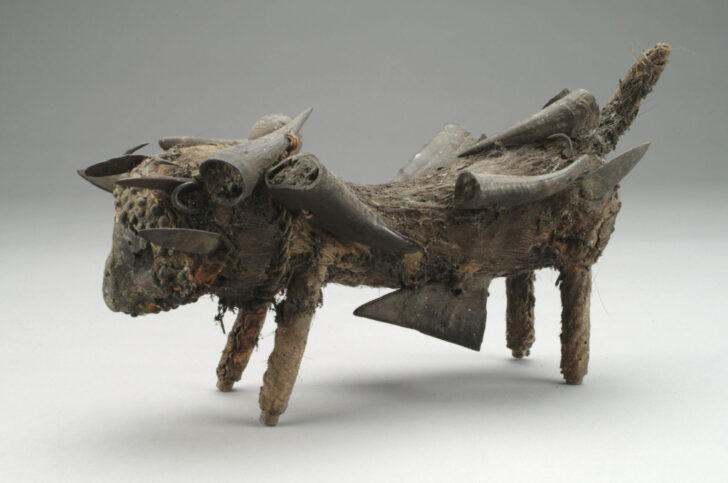Power Figure
Luba

Description
Subject Matter:
This dog figure is a rare and exceptional example of a zoomorphic nkisi mihake (pl. minkisi mihake), or “malevolent” power object, and is attributed to the Kasai subgroup of the Luba, who resided in the Democratic Republic of the Congo. Falling under the Luba sculptural genre known as minkisi mihake, these figures are regarded as receptacles for evil spirits, whom the living invoke in order to inflict harm upon another, to avenge an adversary, or to gain supernatural strength for oneself in order to commit a particularly vile action. Such figures are designed and operated by practitioners of "black magic" on behalf of their clients.
Similar depictions of dogs, often covered in nails and metal blades, are commonly seen in the sculptural work of the Vili and the Yombe of the lower Congo. In Central African thought, the dog is a privileged, bivalent animal, allowed to live amongst people in the village (the domain of the living) and to go hunting amidst the brush and forest (the domain of the spirits). They are regarded as possessing clairvoyance and the ability to detect invisible forces. As skilled hunters, the dog is able to both pursue and dispatch enemy spirits. The menacing visual appearance of this nkisi is intended to signal to its viewer its potent efficacy as an object of power.
Reference:
Maurer, Evan M. and Niangi Batulukisi. Spirits Embodied: Art of the Congo, Selections from the Helmut F. Stern Collection. Minneapolis: The Minneapolis Institute of Arts, 1999.
Physical Description:
This zoomorphic Luba nkisi mihake, or “malevolent” power object, depicts a dog of a fierce and formidable character. Sculpted out of wood, the dog has been carefully covered in animal fur, creating a graphic mimetic effect. The dog’s tail stands nearly upright, signaling a commanding and attentive posture. Most striking, however, are the antelope horns, stuffed with medicinal substances, as well as the metal blades that have been affixed throughout the dog’s trunk and underbelly.
Usage Rights:
If you are interested in using an image for a publication, please visit https://umma.umich.edu/request-image/ for more information and to fill out the online Image Rights and Reproductions Request Form.